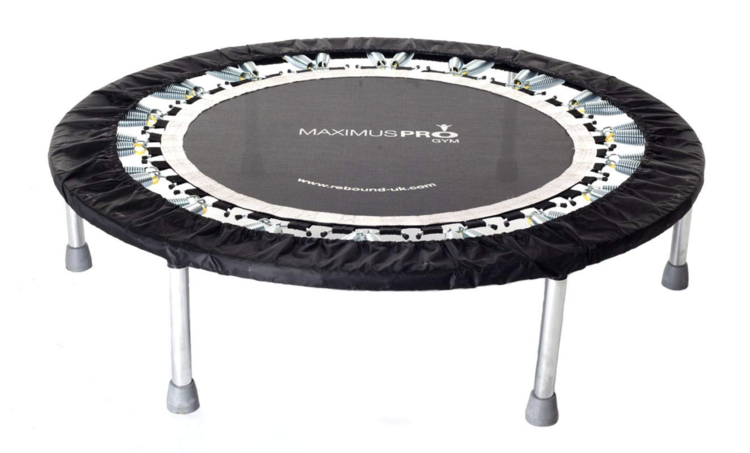Rebounding and the Pelvic Floor

Have you heard of a "Rebounder?"
It sounds super-fancy, but essentially, it's a mini-trampoline. "Rebounding" has become a popular exercise for its cardiovascular benefits and because it protects the joints from the fatigue and impact of exercising on hard surfaces (such as running on pavement).
Rebounding is reported to be an effective tool for weight loss and detoxification of the body. It can improve digestion and elimination, and it promotes lymphatic flow (although to be fair, anything that increases circulation will improve lymph flow!).
I received the following question from a client:
Hi Bri, I have been wondering if using a Rebounder is good for pelvic floor strength. I have used one before — and loved it — but I found I was leaking (urine). I stopped, figuring it was damaging my pelvic floor. But now I hear that it is good for the pelvic floor... Or maybe that is just hype from the companies that make Rebounders?
Below is my response:
I have a mini trampoline, and I love it. Whenever I drag it out, I love the feeling I get after jumping for 5-6 minutes. So invigorating! Rebounding is a less "jarring" cardio option than running on pavement or other hard surfaces, making it easier on your joints and pelvic floor.
However, if you have problems with bladder leakage and/or prolapse, rebounding might aggravate/increase your symptoms if your pelvic floor muscles aren't ready for the impact. Here are a few tips to help:
-
BEFORE you step onto your Rebounder, empty your bladder.
-
BEFORE you step onto your Rebounder, "prime" your pelvic floor with a few Kegels to remind your body (and brain) that these muscles need to be alert and responsive while bouncing. You don't want your pelvic floor to be clenched and gripped the entire time, but you do want your pelvic floor muscles to be "online." Kegels can help wake them up!
-
Note: when doing Kegels, remember to RELAX fully after each contraction!
-
-
When you're ready to jump, start SLOW. Think "baby steps."
-
Carefully step onto your Rebounder. Start with gentle bounces or just lift your heels off the trampoline (without ever leaving the surface).
-
Aim for half of what you think you “should” be able to do. For example, start with a 30-second bounce session instead of 1-2 minutes. Choose an amount that will allow you to see success (and gradually progress from there).
- After your short trial session, check in with yourself. How did it go? Any symptoms such as pelvic heaviness or bladder leakage? Any pain or discomfort? If so, stop for today. If not, you can bounce a little bit more!
-
At first, avoid high-impact moves, using hand weights, or jumping with your legs far apart. Instead, start with gentle bouncing or jogging-in-place and see how that feels. As stated above, you can also just lift your heels so that you're never leaving the surface.
-
If you’re concerned about bladder leakage, **gently** engage your pelvic floor/core muscles while bouncing. You must remind your pelvic floor how to stay "extra on" during this activity. It takes time to improve body awareness and endurance of the core muscles, but it can be done!
-
Caveat: although your pelvic floor will need to be “extra on,” please don’t clench or grip your pelvic floor muscles. Think supple and responsive — like your pelvic floor is a bouncy, resilient, flexible trampoline — rather than tight and stiff.
-
-
As your pelvic floor (and entire inner core) gains strength and your body gets more accustomed to bouncing, you can try bouncing without a conscious sustained "kegel-like" contraction of your pelvic floor. Rather, focus primarily on your breathing. Breathe smoothly and easily, and NEVER-EVER-EVER hold your breath. The ultimate goal is to teach your muscles how to ANTICIPATE the impact of each bounce, and how to turn on and protect you WITHOUT having to "grip" the whole time. The other goal is to keep breathing!
-
Work up to longer bouncing sessions slowly. This is a gradual process; it takes time and patience! Don't push yourself too far, too fast.
Let's go through this in more detail.
How to bounce if you have bladder control issues*:
-
Make sure your bladder is empty before starting.
-
Step onto your rebounder/trampoline.
-
Before bouncing, engage your pelvic floor muscles (do a gentle kegel). Note that I said GENTLE... This should not feel like a clench! "Squeeze and lift" your pelvic floor muscles using the same pressure you would use to test a ripe avocado. Feel like you're "scooping up" your pelvic organs (especially if you have mild pelvic organ prolapse) and supporting them from below. Try to keep your buttocks relaxed. VERY GENTLY draw in your lowest band of abdominals without tucking your tailbone under or thrusting your ribs forward. Pretend like you're zipping up a pair of high-waisted jeans. If your lower ribs pop forward, draw them in by "buttoning up" the top button of your (imaginary) jeans.
-
Hold this gentle "pelvic floor first” core activation as you begin doing mini bounces or jogging-in-place on your trampoline. Don't hold your breath. Breathe naturally, even though you're holding a gentle activation of the pelvic floor muscles. Start with just a 30-60 seconds, and see how you do.
-
Stop bouncing, release your pelvic floor/core, and tune in. How did it feel? If you’re good, do it again, but for a bit longer.
-
After 1-2 minutes of successful bouncing with conscious pelvic floor/core activation, safely step off the trampoline.
-
When you're feeling steady off the trampoline, COMPLETELY RELAX your core and pelvic floor muscles. Let it all go. Shake it out!
-
Check-in with yourself: How are you feeling? Are you dry (no leakage)? Are you still feeling light and supported in your pelvic region?
-
If so, get back on the trampoline, this time WITHOUT an active/conscious contraction (i.e. without a sustained "kegel" contraction). Trust that your body will know what to do. Trust that your pelvic floor will be able to support you with its natural level of supple + responsive muscular control. Try bouncing for 30-60 seconds without the sustained “kegel.” Please don’t hold your breath, and don't push it too far.
-
If you experienced leakage or a feeling of pressure this time, then you're not (currently) able to bounce without actively/consciously engaging your pelvic floor. That's fine, but it also means that you shouldn't jump for much LONGER than 1-2 minutes (at this time). Why? Because you don't want to have to actively "kegel" throughout a long bounce session. Too much active holding (i.e. "kegeling" for too long of a period) can lead to clenching, gripping, and excessive pelvic floor tension. This can cause feelings of bladder urgency/frequency, it can cause pelvic pain and discomfort, and it can WORSEN your symptoms of pelvic organ prolapse and/or hinder recovery.

This is a process of self-inquiry and gradual introduction (or re-introduction) to the activity of rebounding. Using the steps outlined above, slowly work up to longer bouncing sessions as long as you stay dry and comfortable. If you are NOT staying dry, consider this a signal from your body that something isn't right. Consult a pelvic floor physical therapist for one-on-one evaluation and treatment. And check out my Lift program for at-home support!
*Note: This is not to be used as a substitute for medical advice. If you have moderate to severe pelvic organ prolapse, or significant bladder leakage, bouncing might not be a good option for you at this time. Everybody is different, and not every exercise works for every person. For additional help specific to your needs, contact a women's health physical therapist in your area.
"Good" or "bad" for the pelvic floor:
Rebounding is an effective workout for the entire body. I wouldn't say that it's particularly "good" — i.e. any better than other activities, such as walking — for your pelvic floor, but it's certainly not "bad" as long as it's not aggravating your condition! If you're having issues with bladder leakage or feel that it's worsening your pelvic organ prolapse, STOP and contact a women's health physical therapist. Individualized pelvic floor rehabilitation from a professional trained in this specialty is a better option than simply grabbing a box of incontinence protection and continuing an activity that might be making matters WORSE for you.
This leads me to a point that I want to make SUPER clear:
Rebounding is an example of a time when it is appropriate to gently "zip up" and actively engage the pelvic floor/core muscles, at least at first, as you're re-training your inner core on how to handle the demands of this activity (i.e., how to respond to the force of the elastic recoil). However, you do NOT need to "zip up" all day long. Conscious, active "zipping" is only required when you are:
-
Doing something strenuous such as lifting, bending, pushing, pulling (some examples: moving a box, lifting your dog, vacuuming...)
-
Doing focused core strengthening exercises or weight lifting/resistance training
-
Doing activities that require extra stability, balance, and control (such as standing on a ladder)
-
Doing things that might be jarring to the pelvic floor, such as bouncing, running, etc.
At other times — during normal, non-rigorous activities of daily living — do not worry about actively "zipping." Use good posture and relax the core.
Your core muscles are constantly firing — continuously "on," albeit at a low level — throughout the day. If they weren't "on," you couldn't stand up.
Zipping makes them "extra on," you do NOT want to overly tax your muscles by zipping up the core all day. Too much zipping creates excessive muscle tension and can lead to pain and dysfunction. Watch the video below to learn more about when you should actively “zip,” and when you should let go!
In summary:
Rebounding is great for the entire body — and is perfectly fine for the pelvic floor — as long as your pelvic floor muscles are ready for it. They might need to be re-trained as described in the steps above. Work up to it slowly. If you feel that rebounding is aggravating your symptoms of bladder leakage or pelvic organ prolapse, contact your physical therapist.
FOR MORE PROLAPSE SUPPORT, CLICK HERE TO LEARN MORE AND GET THE FIRST WEEK OF MY “LIFT” SERIES FOR FREE.
Don’t forget to contact a women’s health physical therapist in your area for diagnosis and treatment specific to your needs!
*NOTE: This website in general, and this article specifically, is for general information and educational purposes only. It is not intended to diagnose or treat any medical condition, but rather to understand what options are available. Please seek the advice of a physician to properly diagnose your symptoms.
Does your pelvic floor need help?
Many women think they just need live with the changes they’re experiencing
“down there,” but this is NOT the case. Take the short quiz to find out if you have issues that can be solved naturally.









